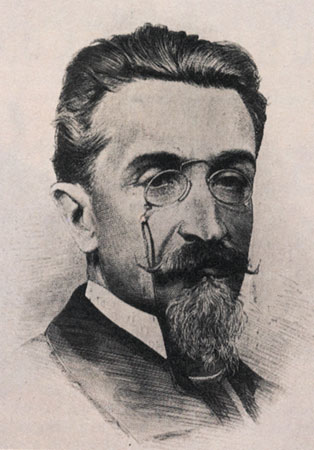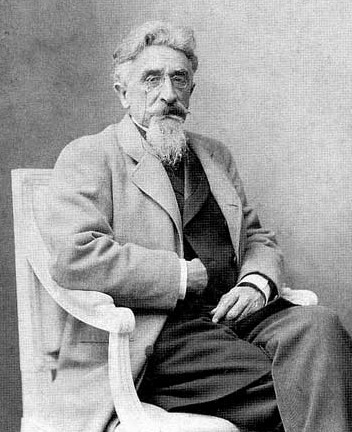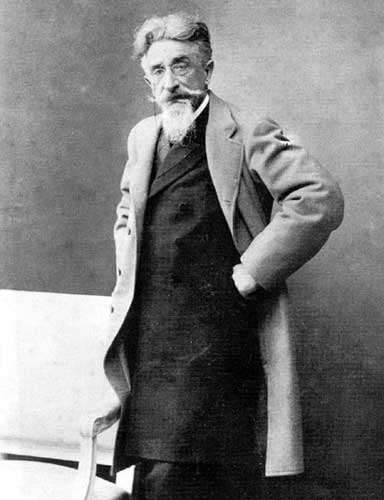<Back to Index>
- Mathematician Nicolaus II Bernoulli, 1695
- Novelist José María de Pereda, 1833
- Cuban Revolutionary Camilo Cienfuegos Gorriarán, 1932
PAGE SPONSOR



José María de Pereda (February 6, 1833, Polanco, Cantabria — March 1, 1906, Polanco) was one of the most distinguished of modern Spanish novelists.
He was educated at the Institute Cántabro of Santander, whence he went in 1852 to Madrid, where he studied with the vague purpose of entering the artillery corps. Abandoning this design after three years' trial, he returned home and began his literary career by contributing articles to a local journal, La Abeja montañesa in 1858. He also wrote much in a weekly paper, El Tío Cayetín, and in 1864 he collected his powerful realistic sketches of local life and manners under the title of Escenas montañesas ("Mountain scenes").
Pereda fought against the revolution of 1868 in El Tío Cayetín, writing the newspaper almost single-handedly. In 1871 he was elected as the Carlist deputy for Cabuérniga. In this same year he published a second series of Escenas montañesas under the title of Tipos y paisajes; and in 1876 appeared Bocetos al temple, three tales, in one of which the author describes his disenchanting political experiences.
The Tipos trashumantes belongs to the year 1877, as does El Buey suelto, which was intended as a reply to the thesis of Balzac's work, Les Petites misères de la vie conjugale. More and more pessimistic as to the political future of his country, Pereda took occasion in Don Gonzalo González de la Gonzalera (1879) to ridicule the Revolution as he had seen it at work, and to pour scorn upon the nouveaux riches who exploited Liberalism for their personal ends. Two novels by his friend Pérez Galdós, Doña Perfecta and Gloria, drew from Pereda a reply, De Tal palo tal astilla (1880), in which he endeavours to show that tolerance in religious matters is disastrous alike to nations and to individuals. The Esbozos y rasguños (1881) is of lighter material, and is less attractive than El Sabor de la Tierruca (1882), a striking piece of landscape which won immediate appreciation.
New ground was broken in Pedro Sánchez (1883), where Pereda leaves his native province to portray the disillusion of a sincere enthusiast who has plunged into the political life of the capital. Pereda's masterpiece is Sotileza (1884), a vigorous rendering of marine life by an artist who perceives and admires the daily heroisms of his fisher-folk. It has often been alleged against the author that he confines himself to provincial life, to lowly personages and to unrefined subjects, and no doubt an anxiety to clear himself from this absurd reproach led him to attempt a description of society at the capital in La Montálvez (1888), which is certainly the least interesting of his performances. In La Puchera (1889) he returned to the marine subjects which he knew and loved best. Again, in Peñas arriba (1895), the love of country life is manifested in the masterly contrast between the healthy, moral labor of the fields and the corrupt, squalid life of cities.
Pereda's fame was now established; the statutes of the Spanish Academy, which require members to reside at Madrid, were suspended in his favor (1896). But his literary career was over. The death of his eldest son, the disastrous campaign in Cuba and the Philippines (during the Spanish-American War), darkened his closing years, and his health failed long before his death.
Pereda belongs to the native realistic school of Spain, which, founded by the unknown author of Lazarillo de Tormes, was continued by Mateo Alemán, Cervantes, Quevedo, Castillo Solórzano and many others. With the single exception of Cervantes, however, the picaresque writers are almost entirely wanting in the spirit of generous sympathy and tenderness which constitutes a great part of Pereda's charm. His realism is purely Spanish, as remote from Zola's moroseness as from the graceful sentimentality of Pierre Loti. Few 19th century writers possessed the virile temperament of Pereda, and, with the single exception of Leo Tolstoy, none kept a moral end more steadily in view. This didactic tendency unquestionably injures his effects. Moreover, his grim satire occasionally degenerates into somewhat truculent caricature, and the excessive use of dialect and technical terms (which caused him to supply Sotileza with a brief vocabulary) is a grave artistic blemish. But he saw, knew, understood character; he created not only types, but living personages, such as Andres, Cleto and Muergo in Sotileza, Pedro Juan and Pilara in La Puchera; and he personified the tumult and calm of the sea with more power than Víctor Hugo displayed in Les Travailleurs de la mer. His descriptive powers were of the highest order, and his style, pure of all affectations and embellishments, is of singular force and suppleness. With all his limitations, he was as original a genius as Spain produced during the 19th century.